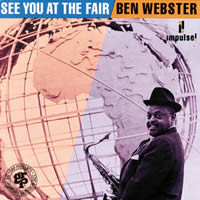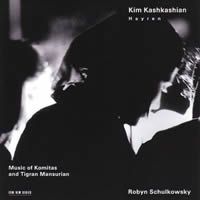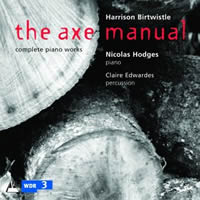Kipple 2.
|
[We welcome Bart Scribner to La Folia. We’ve long known of his insightful, gracefully written commentaries and are honored to post a sampling here. We hope this is only the second of many such appearances. Ed.] Bart Scribner [August 2005.]
Ben WEBSTER: See You at the Fair (1965). Webster (tenor sax), Hank Jones (piano), Roger Kellaway (piano, harpsichord), Richard Davis (bass), Osie Johnson (drums). GRP GRD-121 (http://www.vervemusicgroup.com/). See you at the garage sale, in this case. While new it went largely ignored; Webster had moved to Europe before it came out, and his style was in eclipse. Nine months later Coltrane’s A Love Supreme would be taped in the same studio — events in alien galaxies. Still, Fair contains numbers Webster never surpassed. The half featuring pianist Hank Jones (rec. 3-11-64) is the more kingly. “Someone to Watch Over Me” gets Webster’s finest ballad manner, tender but never sloppy, notes wilting at the edges in his trademark flourish. It may take several repeats to digest Jones’ lovely inlay work behind him, but the piano solo is a model of lightness, clarity and charm. “Over the Rainbow” and “Our Love Is Here to Stay” are handled with comparable authority, but I’m most taken with Ellington’s “The Single Petal of a Rose”; Jones’ rippling runs elicit grand sax phrases over arco bass. The Duke’s “In a Mellow Tone,” from Webster’s stay with the band, is less mellow than any of these. Webster still pushes it along, as each of the others in turn shines in the spotlight. Recorded two weeks later, the remainder is less consistent. Roger Kellaway replaces Jones, to diminished effect. Another tune Webster had been playing for decades is of course “Stardust.” Breathy arrivals and departures are delicious and the climactic statement, delivered alone, moves one. The timing of 2:24 merits comment; those brought up on 78s knew how to enter, put it across and exit. “See You at the Fair” is Webster’s own uptempo blues, his roughened tone propelled by Davis and Johnson. The love theme from The Fall of the Roman Empire (1964’s edition of Gladiator) sits oddly despite the martial rhythm, but Webster’s sax is a major upgrade from the original’s soupy strings. Harpsichord must be the only interest Webster and Albert Ayler might’ve shared, but its role on the next two tracks is about all that recommends them. The ’65 notes patiently explain what a harpsichord is (in the year of Leonhardt’s second Goldberg recording!). To boost the disc length to 49:28, two items from arranger Oliver Nelson’s More Blues and the Abstract Truth (also 1964) have been added. Webster grabs an occasional lead, but this isn’t a star vehicle. I’m no admirer of Nelson’s slick, prolix charts, now even more passé than the honorable pre-bop ethos Webster represents. Hank Jones turned 87 on July 31. His duets with Charlie Haden of traditional source music (Steal Away, Verve, 1995) should be in every American collection.
“Hayren.” Tigran MANSURIAN: Havik (1998), Duet for Viola and Percussion (1998). KOMITAS (arr. Mansurian): Songs. Mansurian (piano, voice), Kim Kashkashian (viola), Robyn Schulkowsky (percussion). ECM New Series 1754 (http://www.ecmrecords.com/). A promotional copy of this 2003 release (minus its fancy retail package) fell into my hands the other day. I can understand the reviewer’s reluctance; seeing it as the Armenian cousin to “Spirituals, Hymns and Folk Songs” (the Haden / Jones album’s subtitle) won’t quite fly, and the contempo side is threadbare. Mansurian (b. 1939) taught 20th-century music at the Komitas Conservatory, especially Debussy, Webern and Stravinsky — a decadent-bourgeois trio for someone in the Soviet orbit. At 40 he declared, “I discovered folklore rather late. Consequently, it is not an integral part of my musical consciousness.” Megadisc MDC 7839, with pieces dated 1981 to 1995, reinforces those words. To what degree his current folk-derived angle is due to the ECM embrace, God knoweth; if he has recently composed for other than the label’s house performers, I’m unaware of it. Hayren provides a snapshot of what he was doing around 1998, with no larger context. Havik (Little Bird) is central in the Komitas canon — one of several he recorded in France in 1912, it can be traced to 10th-century mystic Grigor Narekatsi. Mansurian cleverly gives the accompaniment to shimmering vibes and gongs, while Kashkashian provides a stirring “vocal” on viola; the long opening notes and expected swerves and winding embellishments are perfection. (It’s as natural to her as to Mansurian.) Then I’m baffled. Mansurian has been talked into delivering a suite of Komitas songs in direly inadequate voice — a faint, unsteady, wandering croak that cannot manage the simplest trill. Kashkashian’s fleeting appearances hurt, lending Krunk (Crane) the plaintive declamation absent from the vocal attempt, and indicating where the melody of Hoy, Nazan (Hi, Nazan) should point. (She covers him somewhat, all to the good.) ECM’s refusal to translate even titles argues sound over sense, but the singing expresses little besides discomfort. Duet, a slack 18:22 long, is gestural and random. Pauses emphasize the episodic drift, and any scenario stays hidden. The executants deserve better. On a happier note, Kashkashian’s Kurtág / Schumann encounter (ECM New Series 1508, 1995) scores in every facet. Modernist and Romantic components are (for once) mutually relevant and engaging. Three ways of looking at Komitas: Traditional Crossroads CD 4275 The Voice of Komitas Vardapet preserves the 1912 sessions he and student Armenak Shahmuradian (Komitas at piano) left, rendered via elaborate digital technology. Why not start with the thing itself? New Albion NA 033 Several Armenian choirs have done chunks of his masterwork, the Divine Liturgy. (Tourists need not apply — would that Shostakovich, Janácek or de Falla were so fortunate.) This is probably the least objectionable in sound; the editor praised it in his Fanfare days. Studio Nova SNR 41001 In February the Komitas Quartet marked its 80th year of performing; it’s also an elite unit. Reissuing a 1994 French disc, Studio Nova gives 11 Miniatures new life — Komitas songs in string-quartet guise. They should be sung so eloquently. Haydn’s Op. 54/1 and the brief, unsettled Seventh of Shostakovich complete a potent recital.
Harrison BIRTWISTLE: The Axe Manual (2000), Harrison’s Clocks (1997-98); eight others. Nicolas Hodges (piano), Claire Edwardes (percussion). Metronome MET CD 1074 (http://www.metronome.co.uk/). Distributed in the US by Allegro (http://www.allegro-music.com/). A new Nicolas Hodges CD is always welcome, for his exceptional chops and inquiring spirit. Sir Harrison is mainstream in Hodges’ output, but each work (down to one Birtwistle wrote at 16) receives the same unremitting focus. The Axe Manual is a punning name (Emanuel Ax first played it), but its indefinable poetry filters into the piece. Durable, easily felt concepts (a fast-slow-fast structure, percussion that extends the piano’s reach) spread out in energetic blocks. Marimba and keyboard plinks accelerate into racing laps, the piano not always leading. Talkative bursts are answered on woodblock, before the percussionist moves to vibraphone for the indecently gorgeous quiet dialogs. A Bartókian “Night Music” prevails, ending with chimes in steps and single piano tones. Hodges then gets away fast but the vibes catch up; they exchange volleys before concluding in silence, as they began. Axe must be great fun live. This is the CD premiere (kudos to Claire Edwardes for matching the pianist’s bravura), and so decisive that others may steer clear. Harrison’s Clocks also packs references. I got Birtwistle’s long-held fascination (The Triumph of Time for orchestra, 1971-72); annotator Jonathan Cross cites John Harrison in the 18th century, trying to develop clocks for use at sea. Brutal pattern-making is the rule. Each of the five sections is signaled by a loud downward figure — “something like a clock striking,” the composer says. I puts successive notes in alternating hands, then cranks up the mechanism. Hodges’ separation of rhythmic layers is thrilling. Stopping the machine requires care; here it’s notes in wide intervals. Headlong toccata-like drive also runs the middle and closing chapters, with much isolation of hands (high trilling over left-hand dance motifs in III, attacking the keyboard’s extremes in V). The even numbers pursue other goals; II creeps and chords along until hitting proper speed, and IV’s thick passagework and downturning motion head for a gripping mechanical stall. In between these, eight miniatures (most for specific occasions) hold one’s attention. All are well-made, and some relate to Birtwistle’s main thrust. Précis (1960) is his shot at devising a generic serial ditty. All the features turn up — register-hopping melody, loud chords followed by scampering fingers, overpedaled strikes, silences. The most ambitious (for Boulez’s 75th birthday, it had better be!) is Ostinato with Melody. Over a constantly changing foundation, an insinuating tune asserts itself (one of the disc’s four premieres). I resist pontificating on sound because of my advanced years, but this CD’s is remarkable — hefty in impact and dynamic range. The booklet should be imitated; Birtwistle, Hodges and Cross discuss each item, and score pages are included. Hodges has an attractive site. CD Storage Three teak drawers junked in a condo remodeling hold my discs. Measuring 20W x 17D x 7H inside, each can accept 160 regular jewel boxes (four rows of 40). Stacked, they present a smallish cube. Alternative performances and multi-disc sets have to get used — half a dozen Goldbergs or foot-long CD bricks won’t cut it. Saving space isn’t everything, though. Those flat boxes with their paper sleeves bug me; the CDs are fished out just once and placed in half-width plastic cases. Luckily I need only a few such things. Plenty of room for growth, but vigilance is the key.
[More Bart Scribner, Kipple]
[Previous Article:
Repetition Isn't Always the Same]
[Next Article:
Sworn to Secrecy: A Tale of the CD-R]
|


